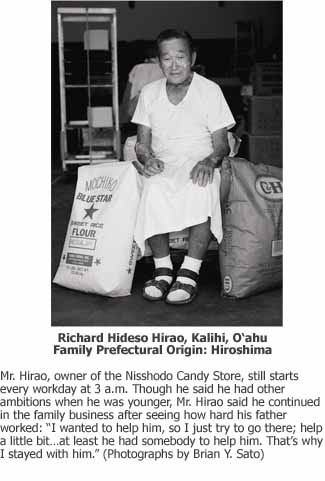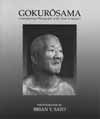A disappointing search for photographic portraits of Hawaii Issei at a university library led me to the realization that the rapidly aging Nisei generation in Hawaii would likewise become “faceless” to future generations unless a photographic documentation was undertaken immediately. In hindsight, it was indeed fortunate that at the time I initiated this project I did not have any notion as to how long it would take to complete.
It began in 2002, now six years and six islands later, it is finally nearing completion. In 2007, with the support of the JCCH (Japanese Cultural Center of Hawaii) and sponsor Liam and Lori Tomoyasu McGee, the exhibition “GOKURŌSAMA Contemporary Photographs of the Nisei in Hawaii” was produced.
“Gokurōsama” is an expression of gratitude directed to someone who has worked hard or made a sacrifice on one’s behalf. GOKURŌSAMA, the exhibition, is dedicated to the Nisei, who have, like their parents before them, made immense sacrifices on behalf of their offspring and society at-large.
This exhibition expressly focuses upon the Nisei as individuals rather than as a group, because too often we pay little attention to the fact that it is the endeavor of individuals that empower and define the group. It was my intention, as a photographer, to give a “face” to the group, and to further personalize the viewer’s experience with the photograph by including an anecdote of the subject with the photograph. To this end, whenever possible, the photography session with each subject also included a brief interview, which, in most cases, was used to aid in the composition of the accompanying captions. The interview also served as a means to quickly get to know the subject in terms of personality and physicality. It proved to be invaluable in determining my “approach” to the creation of each subject’s image.
Having gained a sense of the subject’s persona through the interview, the photographic session would typically begin with a reconnaissance of the physical surroundings of the interview location. Since I prefer to photograph using natural light, more often than not, I photographed outdoors without the use of artificial light sources. More importantly, photographing the Nisei outdoors made it possible to establish a sense of place, which was always a key objective in these portraits of Hawaii Nisei.
I am searching for a variety of things in this walk-through: tonality, shapes, objects within the scene that work to create the desired mood of the image and/or help to convey my interpretation of the subject. Of course, it is a “hit or miss” thing. I may not even know that I have made a “hit” with a portrait until much later. Recently, a relative of a Nisei I had photographed remarked that my photograph of him was, “HIM to a “T.” Apparently, I had included two elements within the image that, unbeknownst to me, were the subject’s two obsessions: jeeps and goats.
A very important criterion for the photo session was that the Nisei wear their “everyday” clothes. There are two reasons for this: the first has to do with the subject’s comfort. We feel most comfortable wearing what we are familiar with, and that breeds relaxation, which, in turn translates to someone who sits, stands and gestures in a way that is “normal” to him/her. Subtle changes in facial expression or hand positions that seem “forced” by the subject due to anxiousness or nervousness can quickly transform the session into an exercise in frustration for me.
The second reason for requiring the Nisei to wear their “everyday” clothes involves the viewer of the photograph. Simply put, clothing can be very revealing of one’s personality. It reveals what we like and dislike, be it color, pattern, style, cut, level of dress, etc. Moreover, especially in the case of the Hawaii Nisei, clothing aided in establishing a sense of place. As with oral storytelling, visual storytelling through a photograph becomes a more visceral and personal experience when more descriptive details of the “place” are provided. For example, a Nisei dressed in a t-shirt, shorts and slippers, sitting on a small wooden stool in his backyard, surrounded by hibiscus and large-leafed banana trees that are blurred due to movement by the wind, provides the viewer with a tremendous amount of environmental and sensory information which enhances the viewing experience.
Having done over a hundred portrait sessions of the Nisei, one interesting conclusion I have come to is that the chances of making a “successful, honest, revealing” portrait of older people are much higher than with younger subjects. And the reason for this, I think, is obvious – maturity. The passage of time nurtures self-acceptance. And having a subject before him who is comfortable with him/her self is a portrait photographer’s greatest ally.
My involvement with photographing the Nisei over the last six years was an education not only in terms of what I gained through the experience that has made me a more aware photographer, but more importantly, in terms of my development as a person. Without launching into a lengthy and probably boring discourse, suffice it to say that because I made the commitment six years ago to undertake this project, which then gave me the opportunity to meet and photograph over a hundred individuals of this generation, I am a better person today. To have had the privilege to listen to and learn from their life stories has been an edifying experience. To all the Nisei out there who agreed to be interviewed and photographed, who gave me a place to stay, and who fed me on countless occasions, and made me laugh and cry with their humorous and heart-wrenching recollections, “Arigatou gozaimashita. Gokurōsama deshita.”*
* * *
Gokurōama: Contemporary Photographs of the Nisei in Hawai'iFebruary 14 - May 24, 2009
Japanese American National Museum
Gokurōsama: Contemporary Photographs of the Nisei in Hawai'i is an exhibition of 35 black & white portraits by Honolulu photographer Brian Y. Sato.
See more info >>www.janm.org/exhibits/gokurosama/
© 2009 Brian Y. Sato






